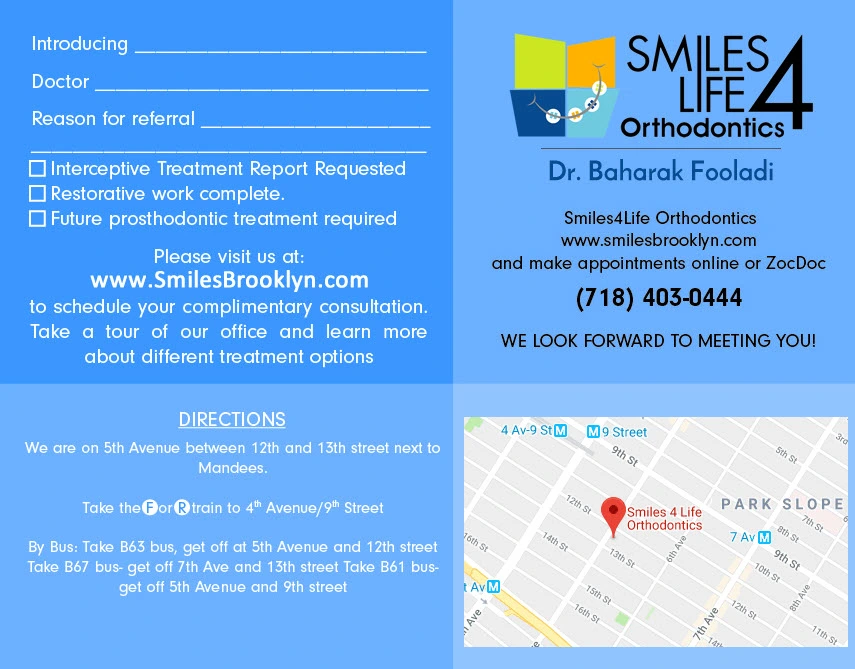Experts recommend that children visit an orthodontist by age 7 for an evaluation to see if early treatment is advised. Some parents may question this timing because most kids haven’t even lost all their baby teeth by that age, wondering if orthodontists are just trying to make a buck. This is not the case with most orthodontists, including Dr. Fooladi at Smiles 4 Life Orthodontics in Park Slope. Our goal is to help patients achieve their best smiles, and sometimes early orthodontic intervention is the ideal plan.
What is two-phase treatment?
The goal of dividing orthodontic treatment into two phases is to maximize the ability to obtain healthy, functional, and aesthetically appealing results that can be maintained for the rest of the patient’s life. Two-phased orthodontic treatment combines straightening the teeth along with changing the physical aspects of the face and jaw to achieve the ideal smile.
What if we skip early treatment?
Delaying treatment may mean more extensive and invasive treatments in the future. It can also eliminate the ability of the orthodontist to fully repair the patient’s smile. Early treatment is sometimes the best way to obtain the ideal, long-lasting desired results.
What is the purpose of Phase One?
The first phase of orthodontic treatment lays the foundation of a beautiful smile. The main goal of this phase is to guide the jaw in developing so that it accommodates all of the permanent teeth and improves how the upper and lower jaws fit together. It is common for children to experience jaw problems as they grow. For example, the upper jaw may grow too wide or too narrow. After age 6, kids with jaw problems can benefit from early orthodontic treatment to avoid future surgical procedures for jaw realignment. Another common issue is crowded front teeth, which can be aided by early treatment to avoid tooth extraction later.
What are common Phase One treatments?
Phase One gives Dr. Fooladi the ability to begin keeping orthodontic records for your child. This may consist of X-rays, photographs, and teeth models, which all help Dr. Fooladi determine if early intervention will be helpful. It also allows Dr. Fooladi to recommend types of appliances, frequency of visits, and treatment duration. During Phase One, the goal is typically not achieving perfectly straight teeth; instead, Phase One focuses on preparing the jaws for the eruption of adult teeth. Patients in this young age group have both baby teeth and adult teeth, which is an ideal time to correct teeth overcrowding and bite issues. Phase One treatment may also protect teeth from damage like chipping, because protruding teeth can be moved into more appealing and safer positions.
What age are kids during Phase One treatment?
Phase One treatment is recommended in about 10-20% of orthodontic cases, typically occurring between the ages of 7 to 11. Treatment usually lasts 10-14 months. Dr. Fooladi will fit most patients with a retainer to wear until Phase Two begins.
What is the resting period?
If a retainer has been recommended, it should be worn during this time as the patient’s remaining adult teeth erupt. In some cases, retainers are not used so that there is greater freedom of movement for erupting teeth. Phase One should have created room for new teeth to grown in correctly however, avoiding impacted or severely displaced teeth. Some patients may need certain baby teeth removed to enhance adult teeth eruption during the resting period. Periodic checkups will be done by Dr. Fooladi during this time to monitor patient progress. It’s important to remember that teeth are not in the final positions after Phase One treatment, as Phase Two will achieve the ending results.
What happens in Phase Two?
The second phase of treatment ensures every tooth is in the best position related to other teeth, lips, cheeks and tongue. This provides for proper function and appearance. This phase usually starts once most or all adult teeth have erupted and the 12-year molars are near eruption. Phase Two can begin as early as age 11 and may be performed throughout a patient’s teen or adult years. Typically, Phase Two involves wearing both upper and lower braces and treatment lasts an average of 18-24 months. Patients are fitted with retainers after braces to help ensure their new smile lasts.
How do we begin the process?
If your child is around age 7, schedule an appointment with Dr. Fooladi at Smiles 4 Life Orthodontics to get started. A thorough examination will be done and records taken so that the best treatment plan can be created. Two phase treatment is not always necessary, but the only way to find out if it’s right for your child is to schedule a consultation to learn more.







